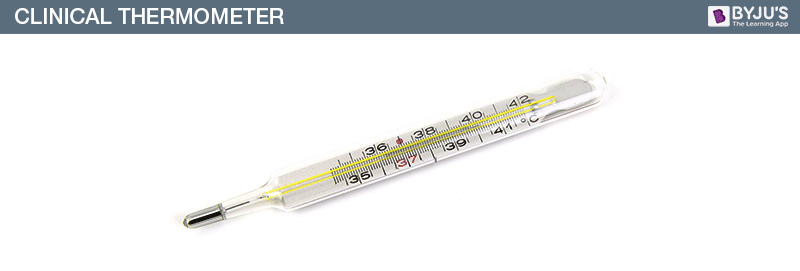Thermometer (thermos: hot; metron: measure) is the universal instrument used to measure temperature. Temperature and heat are two words that often confuse people. For example, how do you explain the hotness of an object? What is the measure or basis for that hotness? The answer to that is temperature. Heat is a form of energy and its unit is Joules. On the other hand, temperature is the measure of that heat. This means, if the heat is more, the temperature is more than well. But how do we measure temperature? We use a device called, thermometer to measure the temperature of any object.
Temperature & Thermometer
By definition, the temperature is the measurable extent of hotness or coldness. It is a mathematical representation of heat. There are different units to measure temperatures, like Celsius (˚C), Kelvin (K), and Fahrenheit (˚F).
There are different types of thermometers that are classified according to their needs. For example, there is one set of thermometers that are used to measure body temperature while another set of thermometers to measure boiling point and freezing point during experiments. Here, we will discuss the two types of thermometers, namely, clinical thermometer and laboratory thermometer.
Properties of Thermometric Liquid
- The liquid that is used in the thermometer needs to have some properties, and they are listed below:
- The liquid used should be visible.
- The thermal expansion of the liquid must be uniform.
- The freezing point of the liquid used must be low.
Types of Thermometer
Following are the different types of thermometers that we use on a daily basis:
- Clinical thermometer /medical thermometer
- Laboratory thermometer
- Digital thermometer
- Infrared ear thermometer
- Mercury thermometer
- Alcohol in glass thermometer
- Constant pressure gas thermometer
- Constant volume thermometer
- Platinum resistance thermometer
- Thermocouple thermometer
- Pyrometer thermometer
Clinical Thermometer
Clinical thermometers are meant for clinical purposes. It is developed for measuring the human body temperature. It is a long narrow glass tube with a bulb containing mercury at the end. The normal human body temperature is 37˚C; which can fluctuate between the ranges 35˚C to 42˚C. Hence, the clinical thermometers have the range 35˚C to 42˚C. The level of mercury tells our body temperature in ˚C. Since mercury is a toxic element, thus these thermometers have been replaced by digital thermometers nowadays.
Note: Clinical thermometers must be sterilized before use for the safe and clean check-up.

How to read a Thermometer?
- The thermometer is washed with water at a normal temperature.
- It is given a few jerks. We notice that the jerks bring the level of mercury down. We make sure that it falls below the 37⁰C mark or the 98⁰F mark, the normal human body temperature.
- The thermometer is then kept under the tongue or under the arms in order to get the reading on the thermometer.
- The thermometer is then held close to the eye as shown in figure 3 in order to see the correct reading.
- The temperature difference indicated between the two bigger marks is noted. Also, the number of divisions (shown by smaller marks) between these marks is noted. For e.g. the bigger mark reads 10 and the number of division is 5, then each division reads the value equal to 10/5 = 20

- We note the value of the bigger mark that the mercury thread has crossed (which is 98 in the Fig.4 Example 1). Then the number of the division of the mercury thread has crossed is noted (3 in this case). Now, this value is multiplied by the value of one division (which is 0.2 in this case). Hence, the temperature reading is 98 + (3×2) = 98.6.
Laboratory Thermometer
Since clinical thermometers can’t be used to measure temperature other than the human body, we need a special type of thermometers for other purposes. A laboratory thermometer, which is colloquially known as the lab thermometer, is used for measuring temperatures other than the human body temperature. It ranges from -10˚C to 110˚C. Laboratory thermometers are designed for lab purposes such as checking boiling point, freezing point, or temperature of other substances. You can use a laboratory thermometer for checking the temperature of a solvent but not a clinical one.

Learn more about thermometers, heat energy, and temperature with BYJU’S engaging video lectures.
Digital Thermometer
These thermometers are used for measuring the temperature by the means of an electronic circuit. The information captured is sent to a microchip that processes it and gets displayed numerically on the digital screen. They are easy to use, inexpensive, and accurate. Digital thermometers can be considered to be advanced thermometers that are used for measuring body temperature.
How to use Digital Thermometer?
- Turn on the thermometer and click till the number zero appears on the display.
- Place the tip of the thermometer under the armpit.
- Wait for a few seconds before you hear the alarm from the thermometer.
- Remove the thermometer and check for the temperature on the display.
- After use, clean the tip of the thermometer with cotton and alcohol.
Infrared Ear Thermometer
Checking the body temperature using the inside of the ear is known as tympanic membrane temperature. This method is common when the temperature needs to taken from the children as it is quick. Infrared thermometer captures the temperature in the form of infrared energy given off by the heat source. The normal ear temperature in adults is 37.5℃.
How to use Infrared Ear Thermometer?
- The tip of the thermometer should be placed inside the ear pointing towards the nose.
- The power button on the thermometer should be pressed until a signal is heard.
- Read the temperature value.
- Remove the thermometer from the ear and clean the tip with cotton and alcohol.
Make sure the thermometer is not used for the ear containing a lot of wax.
Thermometers such as mercury thermometers, alcohol in glass thermometer, constant pressure gas thermometers, and platinum resistance thermometers are designed on the basis of technology.
Watch the video below to understand the effect of temperature on matters surrounding us.

Mercury Thermometer
These thermometers are not used in some sectors since they can easily break. Mercury is a poisonous liquid that can cause health hazards. Mercury thermometers are used to provide accurate temperature readings. It used to measure the temperature under the arm, orally and rectally.
Alcohol In Glass Thermometer
These are thermometers composed of sealed glass. Alcohol In Glass Thermometer shows the temperature by the level at which mercury or alcohol reaches a graduated scale. Temperature is indicated by the changes in liquid. Alcohol In Glass Thermometer features coloured alcohol due to the danger of contact with mercury.
Constant Pressure Gas Thermometer
A constant pressure gas thermometer can function at constant pressure and volume conditions. Constant pressure gas thermometer offers highly accurate measurement and is used to adjust other thermometers.
Constant Volume Gas Thermometer
In a constant volume gas thermometer, the pressure increases when the temperature increases. Constant volume gas thermometer measures temperature in the range 0k to 500 k.
Platinum Resistance Thermometer
Platinum Resistance Thermometers uses a platinum wire attached to an electrical resistance to measure the temperature. Generally, these thermometers are used to measure outside temperatures. Platinum Resistance Thermometers are slow and offer accurate readings.
The resistance of the material in the thermometer increases when the temperature increases. Platinum resistance thermometers measure temperature in the range of 500 k to 2300 k.
Thermocouple Thermometer
These devices are used for the quick measurement of temperature. It finds its application in laboratories. Electrical resistance is used in the device to generate a voltage that varies according to the connection temperature. It also measures temperature in the range of 500 k to 2300 k.
Pyrometer Thermometer
It is the thermometer that operates on Stefan’s law. This device measures the temperature from the heat radiation emitted by the objects. These thermometers can be used without being in contact with the objects. A pyrometer Thermometer measures a temperature greater than 2000 k.
Read more about: Heat and Classification
Frequently Asked Questions – FAQs
What are the properties of alcohol for thermometers?
The following are the properties of alcohol for thermometers:
- The freezing point should be less than -112℃.
- The boiling point should be 78℃.
- The colour of the alcohol should be bright.
- It should a good insulator of heat.
- Measuring high temperatures should be feasible.
How do you know if a thermometer is accurate?
To check if a thermometer is accurate, we need to insert the stem of the thermometer in the ice water such that the stem is at least an inch deep without touching the glass. Wait for a minute or less so that the thermometer registers the reading of the ice water. If the thermometer reading is 32℉ or 0℃, then the thermometer is said to be accurate.
Who is the father of thermometer?
Daniel Gabriel Fahrenheit is considered to be the father of thermometer. He was a German physicist who dedicated his life to science and inventions. The modern mercury thermometer was invented by Fahrenheit. He is also credited for the invention of the mercury-in-glass thermometer.
Why is mercury a good choice for thermometer?
Mercury is in a liquid state at room temperature and has the highest coefficient of expansion. Therefore, even the slightest change in temperature is notable. Also, the boiling point of the mercury makes it suitable for measuring higher temperatures. The other reason why mercury is used in thermometers is that it does not stick to the surface of the glass and has a shiny appearance.





It is a good and intelligent app
Very nice for understanding the topics.
What an app this is, mind blowing. For the first time I am watching education with visualising.
Nice explanation
Very good
Explanation is nice
It’s a nice one
I really like it